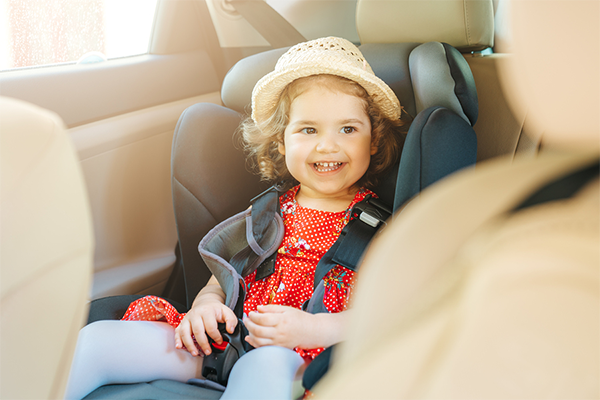Is your child’s car seat or booster installed correctly?
Most of us would probably say yes. But according to Safe Kids Worldwide, a whopping 73% of car seats aren’t. And out in the field, Safe Kids Greater Augusta Coordinator Renee McCabe, RN, says that number is probably closer to 90%.
“The right car seat for your child is the one that’s right for their age, height and weight, that fits in your vehicle correctly and is facing in the right direction,” she said. “It doesn’t matter how educated you are or how expensive your seat is: It won’t keep your child safe if it doesn’t fit your child and it isn’t installed the right way.”
So whether you’re brand new to this whole car seat thing or have used one for a while, here’s a checklist of easy tips every parent should know.
1. Get help installing your child’s car seat. Even if you feel 100% confident about installing your child’s seat, get someone to check behind you. That’s what McCabe does every time she does a car seat check for a family. “When Safe Kids does any car seat checks, I pair two technicians so they can double-check,” she said.
If you’re still learning how to install a car seat, call Safe Kids at 706-721-7606 to ask about scheduling an appointment with a Child Passenger Safety Technician, or CPST.
Then, video how the tech does the installation in case you need a refresher. All car seat manufacturers also offer videos online on how to install their seat. In addition, your car’s manual will have instructions, including where you can install a car seat (some smaller cars may say not to install a car seat in the center, for example).
2. Remember: For rear-facing, more isn’t better. For rear-facing car seats, many parents think the seat should be rock-solid. That’s not necessarily true, says McCabe, since tightening the straps down too much could pull the seat in the wrong recline position. Also, do not use both the seat belt and the LATCH to secure the seat, since that might place too much force on the seat and damage the belt; choose the option that’s easiest for you to install the seat correctly.
Focus instead on how the seat moves from side to side. For safety, it shouldn’t move any more than an inch from side to side at the seat belt path.
3. For forward facing, use the tether. Always. More than 50% of parents don’t use the tether when securing a forward-facing car seat. But the tether absolutely has to be used in order to protect your child’s spine and brain; without it, a car seat could throw your child as much as 8 inches during a crash. Look for the tether strap at the top back of your child’s seat, and attach it tightly to the tether anchor in your backseat.
4. Still having trouble? Try these hacks. If you’re having a hard time getting your child’s car seat buckled into the seat belt or latch, try reclining the seat (if that’s an option), then tighten. After tightening, return the seat to the upright position. If it still seems too loose side to side, reach under the seat to see if the strap seems loose there; pull across and in toward the seat, then try pulling up again.
5. How you buckle the harness matters. When you buckle your child in, use the pinch test: “You should not be able to pinch any of the webbing up at the shoulder,” said McCabe. If it’s too loose, pull again. Then, make sure the chest clip is at the armpits. If it’s too low, “in a crash, your child will slide down, then propel right out of the car seat since little kids don’t have big shoulders,” said McCabe. But in the right place, the chest clip keeps your child safely in the seat if you have a crash.
6. Know when to replace your car seat. All car seats have an expiration date right there on the label, so pay attention to that if your car seat is being used by multiple siblings. You should also replace your car seat if you’re in a crash. But, the National Highway Traffic and Safety Administration says the car seat may still be used if you were in a minor crash: You were able to drive away from the accident; the door nearest the seat wasn’t damaged; the airbags didn’t deploy; and no one was injured. Still, if you’re unsure at all, the best bet is to replace the seat.
7. Use a car seat or booster for as long as you’re supposed to. The American Academy of Pediatrics says a child should be rear-facing until they max out on the height and weight restrictions on the seat. Rear-facing might seem more inconvenient, especially with a curious toddler, but it’s much safer for your baby’s back, says McCabe. “We have bony prominences on our spines that make them like Legos, but your baby doesn’t have that. Their spinal columns aren’t formed and are more like building blocks,” easier to tumble out of place and hurt the delicate spinal cord.
8. Keep clutter out of the car. That box of Kleenex may weigh less than 5 pounds, but in a crash that’s only 20 miles per hour, it can have 100 pounds of crash force. So secure loose items in the trunk as much as you can.
Finally, while it’s not specifically related to installing your car seat, McCabe wants to share one more car seat safety reminder. “Since April, there have been 34 hot car deaths,” she said. “Most of these were because a parent or other family member were out of their routine and became distracted. So create a reminder—a phone, a purse, even your shoes, placed in the backseat with your child. Keep your car locked if you’re not using it, and never let a child play in your car. In 10 minutes, your car’s temperature can rise by 19 degrees, so take action: If you ever see a child alone in a car in a parking lot, call 911.”




